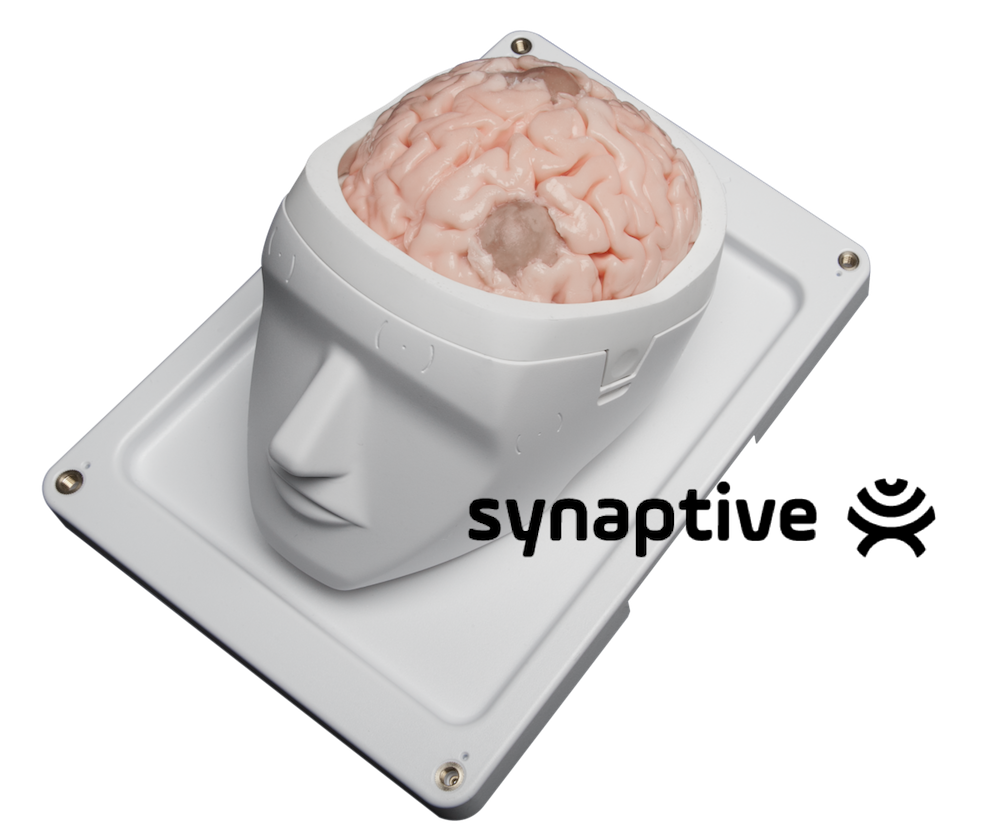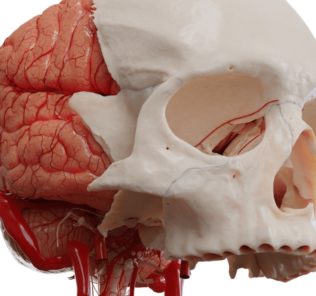Synaptive Medical Innovates Neurosurgery with BrightMatter Brain Simulator & Space Technology
In our field, sometimes it actually is “brain surgery” — and who wouldn’t want to simulate that? Synaptive Medical, a Toronto-based Medtech company, collaborates with clinicians and healthcare systems to deliver products and services that cross traditional barriers and information silos, like their Meningioma Brain Simulator. Their portfolio of BrightMatter solutions include surgical planning and navigation, robotic digital microscopy and informatics, all of which create Connected ORs to help clinicians ensure the best possible outcomes for patients — some of which is technology directly related to the Canadian Space Shuttle Arm. BrightMatter Simulate enables you to effectively practice and evaluate surgical approaches and workflows in an advanced simulation platform by decoupling patient risk from learning.
You may have seen Synaptive Medical’s technology in the new Hulu series “The First”: Originally developed from Canadarm2 technology used on the International Space Station, Synaptive’s first-generation BrightMatter Drive robotic arm with digital microscope was recently featured in the near-future space drama about a group of astronauts attempting to reach the red planet. And just this month, Covenant Health in Texas became the second health system in the state to adopt Synaptive Medical’s BrightMatter technology, allowing their surgeons to perform more brain and spinal surgeries with a higher success rate.
Their unique approaches allow you to replicate clinical workflows experienced in the operating room with remarkably life-like models that mimic the feel of living tissue include brain, vascular, bone and pathological structures. These benign, biodegradable polymeric materials can be used anywhere, without the need for specialized hospital or university training facilities.
Sponsored Content:
About BrightMatter Simulate Product Line
- Simulates brain tissue: Simulates the tactile properties and response of living tissue structures with an anatomically correct cortical surface.
- Technologically agnostic: Provides compatibility with standard instrumentation at the preference of the user such as retractors, resection tools and micro-instruments.
- Provides compatibility with MRI, CT and ultrasound imaging: Allows you to visualize pathologies and anatomical detail with standard radiological imaging modalities, revealing deep-seated lesions and CSF-filled ventricles.
- Optimized for repeat usage: Brain simulator and vessel models enable multiple independent procedures.
- Facilitates multiple configuration options: Variety of configurations and pathologies provides options for simulating various surgical interventions, approaches and workflows.
About The Meningioma Brain Simulator
The Meningioma Brain Simulator features two meningioma targets that simulate the structural and tactile properties of a fibrous meningioma and two tumor targets with tactile response similar to a metastatic tumor. The systems allow for surgeon to practice less invasive neurosurgeries, traditional craniotomies and cerebrovascular skills by integrating and consolidating the critical steps of neurosurgical workflow, including imaging, planning, navigating and target intervention. The solutions include a remarkably life-like brain, meticulously formulated to initiate the tactile properties and response of brain matter, along with an anatomically-correct cortical surface and a suturable dura. The Simulated brains are available in a variety of configurations, providing different options for intervention simulation including the below options:
When used with ventricles, the Brain Simulator contains simulated cerebrospinal fluid-filled lateral and third ventricles, suitable for external ventricular drain placements and features four tumor targets with tactile response similar to a metastatic tumor. The multi-lesion task trainer brain features two tumor targets in the right hemisphere and a 50 cc intra-cranial hemorrhage in the basal ganglia with the consistency of a three to four day clot.
Sponsored Content:
The Brain Simulator is compatible with ultrasound, MR Imaging and CT Scanners. Ultrasound imaging allows users to visualize fluid-filled ventricles for EVD placement. Learners may also confirm pathology position and a successful cannulation during a minimally-invasive procedure. For MRI, T1 and T2 images are included with the holder sets. These include a co-registered tractography series, allowing the learner to consider and evaluate meaningful trajectories to the target pathologies.
The Brain Simulator Bone Caps are designed to be compatible with surgical drills and irrigation tools, providing realistic tactile feedback for burr hole and extended craniotomy workflows. Three configurations are available. Dura products provide authentic responses for dural opening and closing workflows. Finally, with the Simulate Anastomosis Kit, you can simulate tasks particularly applicable to cerebro-vascular surgery including end-to-end anastomosis, bypass and vessel grafting procedures.
About Synaptive Medical
Synaptive Medical Inc. is disrupting the status quo to give surgeons, hospitals, and researchers. Creating technology that addresses surgical challenges while contributing to the best possible outcomes for patients inspires and guides their advancements across medical devices, medical imaging and information science. Synaptive has commercialized eight BrightMatter products in the United States and Canada, and now employs some of the medical device industry’s top leaders and sales professionals. Synaptive continues to hire a high percentage of engineers and scientists with expertise in optics, robotics and image-guided technology to collaboratively develop and commercialize integrated surgical technologies for global markets.
Privately funded and based in Toronto, Synaptive collaborates with leading clinicians and healthcare systems to integrate revolutionary products and services that cross traditional barriers and information silos in and beyond the operating room.
Synaptive’s BrightMatter solution combines surgical planning and navigation, robotic digital microscopy and informatics to create a family of devices designed to capture patient data and deliver it when and where it matters most for surgical decision making. Modus V, the next generation of their robotic digital microscope (shown in the video below), combines the greatest optical power on the market with hands-free automation, offering boundless potential to make surgery more efficient and ergonomic. ImageDrive, their Informatics platform, collects and integrates patient data at all touchpoints in the care process.
The team has developed these products in collaboration with our hospital partners to be cost effective, clinically relevant, and above all, centered on improving patient outcomes. By rethinking the disjointed assortment of analogue technology that dominates existing environments, they hope to deliver medical technology that grows as technology evolves to meet healthcare needs.
Visit the Synaptive Medical Website to Learn More!
Lance Baily, BA, EMT-B, is the Founder / CEO of HealthySimulation.com, which he started in 2010 while serving as the Director of the Nevada System of Higher Education’s Clinical Simulation Center of Las Vegas. Lance also founded SimGHOSTS.org, the world’s only non-profit organization dedicated to supporting professionals operating healthcare simulation technologies. His co-edited Book: “Comprehensive Healthcare Simulation: Operations, Technology, and Innovative Practice” is cited as a key source for professional certification in the industry. Lance’s background also includes serving as a Simulation Technology Specialist for the LA Community College District, EMS fire fighting, Hollywood movie production, rescue diving, and global travel. He and his wife live with their two brilliant daughters and one crazy dachshund in Las Vegas, Nevada.
Sponsored Content:
















